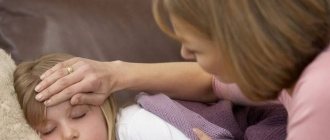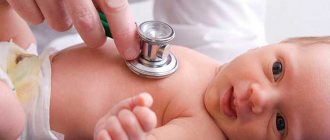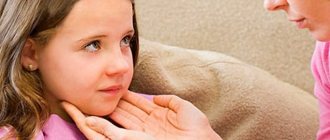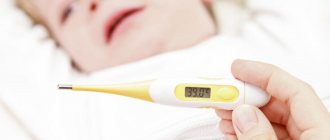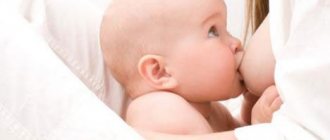How to treat a 10 month old child's throat
A red throat in a 10-month-old child is almost always accompanied by a slight fever. These symptoms may be associated with tooth growth, various diseases of acute respiratory viral infections, acute respiratory infections, sore throat, other viruses, as well as a bacterial infection that causes inflammation. To definitely decide how to treat a 10-month-old child’s throat, you need to know the exact diagnosis. That is, first of all, it is still worth contacting a specialist - a child therapist!
After this, the doctor will prescribe your baby the necessary medications that will alleviate his condition, since choosing such medicines for children on your own is very difficult and even dangerous! These drugs must have all the necessary medicinal properties and have a minimum number of contraindications so as not to harm the baby.
However, it is still worth providing first aid to a small patient. So, first of all, if the patient has a fever, you need to give him one of these antipyretics, available in the form of syrups or suppositories: Nurafen, Viferon, Ibufen, Panadol, Analdim. In this case, the child should not be tightly wrapped and it is advisable to keep him in a well-ventilated area.
Then you can treat a child’s throat at 10 months with folk remedies:
1. Chamomile infusion, which has antiseptic properties, will help. Drinking this way eliminates pain and relieves swelling of the throat. It should be given to the baby before meals three times a day, 1 teaspoon.
2. A good option is a decoction of oak bark, it relieves inflammation and relieves pain. Drink 3 times a day, 1 teaspoon before or after meals.
3. A good remedy is aloe juice, which must first be diluted with boiled chilled water 1:1. The resulting mixture is not drunk, but dripped into the baby’s neck twice a day, 2–3 drops.
4. An amazing remedy - a decoction of dried calendula and eucalyptus. These herbs are brewed in a 1:1 ratio, for example, 2 tablespoons of plants per 200 milliliters of water. This mixture is not boiled, but heated in a water bath under a lid for 5–7 minutes. Then it should be cooled to room temperature and given to the child to drink before meals, 1 teaspoon 3 times a day.
5. Also, from 10 months you can already make warm inhalations from a tablespoon of soda and a liter of boiled water, cooled to 30 degrees Celsius. Such procedures can be performed on the baby 2 to 4 times a day.
6. A very important point during a red throat is a warm drink: tea with squeezed juice of raspberries, cranberries, lingonberries or black currants.
If there is no allergy, you can use the following liquid medications to treat a child’s throat at 10 months:
- oil solution of chlorophyllipt;
— oil with the addition of propolis;
These mixtures are used in a special way: a bandage is tightly wrapped around the index finger, dipped in any of the above solutions, and the resulting swab is used to lubricate the root of the tongue, as well as the walls of the child’s throat. However, before using these products, you should definitely consult a doctor to avoid very unpleasant consequences!
It is not recommended and even contraindicated to treat the throat of a 10-month-old child with drugs that can cause choking or an allergic reaction:
- crushed or whole painkillers or lozenges;
— hot steamed inhalations;
After the pediatrician arrives, you should not ignore taking the medications prescribed by him: antibiotics, antihistamines, antivirals and immunostimulants. Don’t forget, redness and pain in a child’s throat is primarily an infection!
source
How to relieve a severe sore throat
To relieve a severe sore throat, you need to dilute an aqueous solution of propolis in warm water. Take a tablespoon of solution per glass of water. The resulting infusion should be kept in the throat for several minutes. The procedure must be carried out at least 6 – 8 times a day. After 1 - 2 days of this treatment, the symptoms will go away.
At the age of 7 years and older children, a stronger composition can be made. You need to take alcohol tincture in the proportion of 1 tsp. a glass of water and rinse your mouth and throat every 2 hours.
Why does a child have a sore throat?
If a baby complains of discomfort when swallowing, this may be a symptom of a dozen diseases. For some people this is how a cold starts, but for others it is the first sign of tonsillitis and even a manifestation of allergies. Doctors divide the causes of childhood sore throat into several groups:
- Viral infections - the disease affects the entire body (ARVI, acute respiratory infections) and must be treated comprehensively.
- Bacterial ENT diseases - affect individual organs, may be accompanied by the appearance of pus, and are treated primarily with antibiotics.
- An allergic reaction - in dry air or even as a response of the immune system to a new food product. The doctor decides how to treat a child’s throat in such a situation.
- Teething in a baby - a large amount of saliva forms on the back wall, which can irritate the mucous membrane and provoke hyperemia.
Symptoms of sore throat
The clinical manifestation of a sore throat may differ in symptoms depending on the cause that led to the pain symptoms. With a viral infection (influenza, ARVI, parainfluenza and adenoviral infection), hyperemia of the throat mucosa appears, soreness and pain appear. Loss of appetite, pain can radiate to the ears and teeth. At the initial stage of the disease, a dry cough occurs, which is not pronounced. In addition to a sore throat, a child may experience a runny nose, fever, and even conjunctivitis.
In case of a disease that occurs against the background of the active action of enteroviruses and measles, prolonged diarrhea and digestive upset may occur. With measles, a profuse rash appears on the body; with enteroviral pharyngitis, the entire gastrointestinal tract system is upset, possibly bloating and gas formation.
With a bacterial infection, the first thing a sick child experiences is a rise in body temperature, and to such serious levels that pills are sometimes powerless. The tonsils inevitably become red and inflamed, and plaque begins to accumulate on them over time. The onset of a bacterial infection always occurs with a runny nose and sore throat. If measures are not taken and the disease is not treated, the symptoms become more frequent.
If the throat is red, without any other visible changes in the baby’s behavior and symptoms, we can talk about his body’s allergy to some product or to irritating external factors. That is why only a doctor can identify the allergic nature of the disease.
How to treat a child's throat
If the pain intensifies and the baby refuses to eat, cries, you see redness of the back wall, the first thing you should do is change the diet. This is not relevant for infants - they only have mother's milk, but older children need to be given liquid and warm food and ensure plenty of fluids. Remember that sour juices should not be given, otherwise you will aggravate the situation. A couple more nuances:
- For patients over 3 years of age, emphasis can be placed on lozenges.
- Children from one to 3 years old need to treat the oral cavity with antiseptics.
To relieve inflammation in the throat, a remedy based on dry plant extract and essential oil, Sage lozenges from Natur Product, has proven itself to be effective. Sage lozenges from Natur product are a combined preparation containing a complex of biologically active substances¹. It has anti-inflammatory, antimicrobial and expectorant effects, and also has astringent properties¹. Sage lozenges from Natur product have a herbal composition¹. Sage lozenges from Natur product are manufactured in Europe¹ in accordance with international production quality standards.
¹ Instructions for medical use of the drug Sage lozenges. RU. P No. 011411/01 dated 03/02/2009
THERE ARE CONTRAINDICATIONS. BEFORE USE, YOU MUST CONSULT WITH A SPECIALIST
Inhalations
A good way to immediately treat several problems that accompany a sore throat (inflammation, swelling, cough, decreased immunity) is inhalation. They can be hot or cold, depending on the method used to release medicinal vapors. It's easy to understand them:
- Cold - using a nebulizer: a device into which a medicinal solution is poured. This procedure is safe, so it can be used to treat children as young as one year old, but some drugs may have their own age limits.
- Hot inhalations are based on inhaling steam from liquids at a temperature of 80-90 degrees. They can cause burns to the mucous membrane - they are prescribed to patients over 7 years of age.
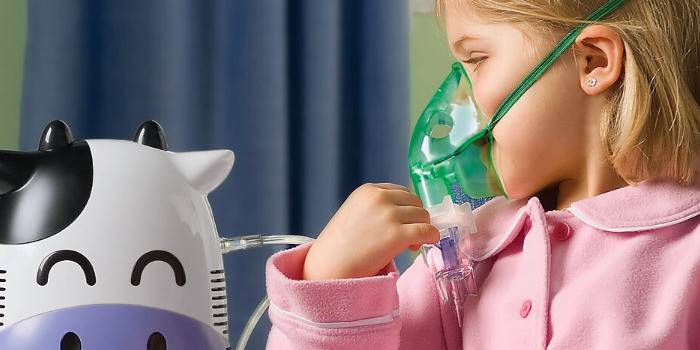
Folk remedies
In the youngest, both the symptoms and the cause of the disease affecting the throat can be treated with alternative medicine recipes: to relieve the condition, infants are given decoctions of sage leaves (you can add a spoonful of honey), and to strengthen the immune system - decoctions of rose hips and currant leaves. Treatment of the throat in children over 3 years of age can be carried out with gargles - diluted tincture of eucalyptus, propolis, infusions of chamomile or calendula.
Drug treatment
Combating a sore throat involves mandatory local therapy, no matter what disease provokes this symptom. Lozenges, rinsing solutions, antiseptics, and even antibiotics in the form of an aerosol that are sprayed into the oral cavity can be used here. Inside, doctors advise:
- antiviral drugs - if you need to treat ARVI or even a cold with complications;
- antibiotics - only as prescribed by a doctor for a short period of time in case of purulent sore throat, the appearance of complications in the lungs and bronchi;
- antihistamines - mainly for laryngitis.
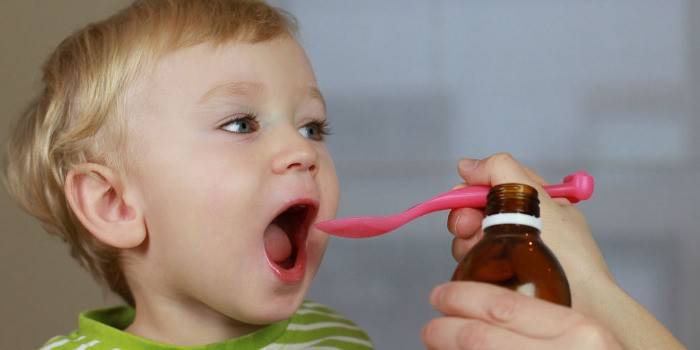
Treatment options
When a child often has a sore throat, it is necessary to take measures to get rid of this condition.
In order to select medications, the source of infection must be determined. If bacteria have entered the body, antibiotics will need to be used to fight them.
The destruction of a viral infection is carried out using antiviral agents. Along with basic medications, bifidobacteria are used to improve the microflora.
Along with drug treatment, rinsing procedures and irrigation are used as additional means.
How to treat a sore throat in a child
Mostly doctors advise the use of antiviral agents and local anti-inflammatory, expectorant, and antiseptic agents. It is necessary to increase general immunity, for which they drink immunostimulants and general restoratives of plant origin, or immunomodulators in suppository format - these are Viferon and Genferon suppositories.
Children under one year old
It is up to the pediatrician to decide how to treat the throat of an infant, since at this age there is increased susceptibility to medications, weak immunity, and it is difficult to carry out most procedures. It is advisable to start treating your baby when the first symptoms appear, since in a critical situation you will have to resort to heavy medications. Mostly doctors prescribe:
Miramistin is an antiseptic for babies over 3 months old, used to treat the oral cavity.
Anaferon is a safe immunomodulator for babies older than 1 month.
Flemoklav Solutab - penicillin series, for babies from 3 months.
Lizobact is an antiseptic in the form of tablets; it is given to infants dissolved in water/milk.
Local preparations for the treatment of throat in children
At the initial stage of the disease, according to doctors, a child can be treated exclusively with means for external use. They are relatively safe, since the active substances are not absorbed into the blood, and are effective due to their influence on the source of discomfort. Local medications include:
- sprays Aqualor and Hexoral;
- tablets Trachisan, Strepsils, Stopangin, which need to be dissolved
- oil solutions for treating the throat.
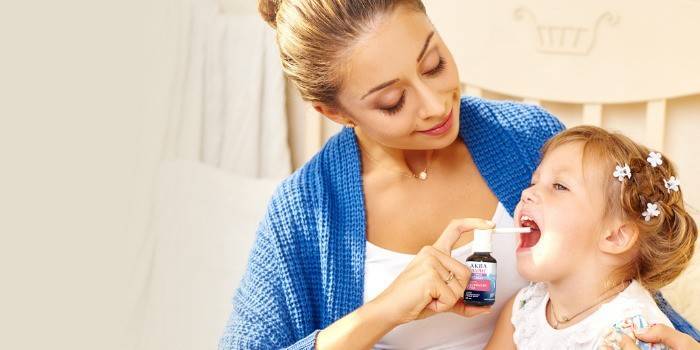
Antiseptic sprays
Medicines in the form of aerosols have a prolonged effect on pathogenic microorganisms. They are used between meals, after which they do not drink or eat for half an hour or an hour. Among these drugs that help with most infectious and inflammatory diseases, special attention is required:
- Hexoral is an antibacterial drug that works even in severe cases of the disease. Relieves pain and has an antiviral effect. Used in children from 6 years to 2 times a day (1 injection at a time). Bottle price – from 340 rub.
- Stopangin - has a hemostatic and antifungal effect, can relieve pain. Children are allowed to use 2 times a day for a week. Price – from 225 rub.
- Yox – relieves inflammation and pain, kills bacteria. Can be prescribed for streptococcal sore throat. For children over 6 years old, use up to 4 times a day. The cost of the bottle is from 250 rubles.
Tablets and lozenges
The most extensive group of local drugs are lozenges and lozenges. They may only have antiseptic properties or influence the production of sputum when coughing, relieve inflammation and pain. When asked how to treat a throat in a child over 3 years old, an ENT doctor can advise:
Topical preparations - sprays - have proven themselves to be effective in the treatment of sore throat, and preparations of a complex composition are more effective. For example, the drug Anti-Angin ® Formula spray, which includes chlorhexidine, which has a bactericidal and bacteriostatic effect, and tetracaine, which has a local anesthetic effect. The convenient spray form allows you to ensure the effect of the active components of the drug exactly where it is needed. Due to its complex composition, Anti-Angin ® has a triple effect: it helps fight bacteria, relieve pain and helps reduce inflammation and swelling 3.
Anti-Angin ® is available in a wide range of dosage forms: compact spray, lozenges and lozenges 1,2,3.
Anti-Angin ® is indicated for manifestations of tonsillitis, pharyngitis and the initial stage of sore throat; this may be irritation, tightness, dryness or sore throat 1,2,3.
Anti-Angin ® tablets do not contain sugar 2*.
*With caution in case of diabetes mellitus, it contains ascorbic acid.
1. Instructions for use of the drug Anti-Angin ® Formula in lozenge dosage form.
2. Instructions for use of the drug Anti-Angin ® Formula in the dosage form of a lozenge.
3. Instructions for use of the drug Anti-Angin ® Formula in the dosage form of a dosed spray for topical use.
There are contraindications. You need to read the instructions or consult a specialist.
- Trachisan is an antimicrobial agent with an anti-inflammatory effect, used for any infectious diseases of the throat. Children dissolve up to 6 tablets per day. Within 5 days the symptoms should disappear. Packaging price – 240 rub.
- Strepsils is an antiseptic that softens the throat and helps relieve cold symptoms. Children (from 5 years old) are given up to 8 tablets per day, the interval between them is 3 hours. The cost of the package is from 160 rubles.
- Septolete is an antiseptic that helps eliminate the symptoms of sore throat and pharyngitis, but at the initial stage. The daily dose for children over 4 years old is 8 tablets, dissolved every 3 hours. Price starts from 210 rubles.
- Chlorophyllipt - based on eucalyptus oil, has antimicrobial activity. The price of the bottle is in the range of 100-140 rubles.
- Lugol - prescribed for sore throat, works on iodine, is an antimicrobial agent. Used up to 6 r/day. The cost ranges from 80 to 110 rubles.
Oil solutions
For children over a year old, doctors advise treating the throat with local medications, and one of the effective groups is considered to be oil solutions that can easily be used to treat the oral cavity (tongue, tonsils, palate) using a cotton swab or gauze. Frequency of use: 3 times a day. Children should not use the oil solution in its pure form: it is diluted with water according to the instructions. The most effective:
Local antibiotics
Drugs in this group must be selected especially carefully, since each virus has its own list of “enemies” to which it is susceptible. Thus, the drug Bioparox (aerosol) is prescribed mainly to a child with tonsillitis; for angina, the emphasis is on clarithromycin; for laryngitis, there is no particular point in antibiotics, unless an additional infection is attached. Gramicidin C tablets, which need to be dissolved, are almost universal: they are prescribed for any infectious and inflammatory processes in the oral cavity.
Inhalation with a nebulizer
A convenient way to deliver the drug to the back wall, where it is difficult to reach when simply lubricating the oral cavity, is to perform inhalation using a nebulizer. You can use several groups and forms of drugs: some doctors even advise crushing a Furacilin tablet and dissolving it in water. Experts often recommend inhaling Dioxidin, Acetylcysteine, Rotokan.
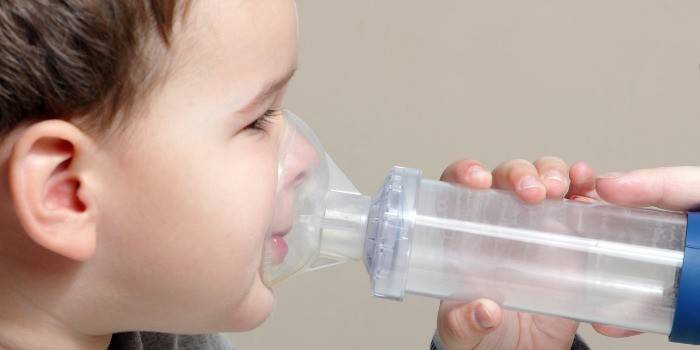
Medicines for treating throat
The following medications are used to treat the throat:
- Agisept lozenges. Can be given to children from 5 years old. Makes breathing easier and soothes inflammation in the throat.
- Anti Angin in lozenges and tablets. It is also recommended for children over 5 years of age. Cope with cough and reduce pain attacks.
- Hexoral. The tablets are suitable for children aged 6 years and older.
- Grammidin in tablet form. Prescribed to children from 4 years of age.
- Imudon tablets. From 3 years of age you can take this dosage form without fear of side effects.
- Laripront. The tablet form of the drug is recommended for use from the age of 3 years. Perfectly relieves swelling of the throat and fights inflammation.
- Septolete. Lozenges are starting to be prescribed to 4-year-old children.
- Strepsils tablets are given from 6 years of age. They dissolve well and eliminate soreness.
- Tantum verde. From the age of 3, the medicine is prescribed to those children who show the first signs of a viral infection.
- Falimint in the form of tablets is prescribed to children from 5 years of age.
- Faringosept is recommended for use from the age of 3 on children with influenza or acute respiratory viral infection.
We recommend: Sore throat in a 2-3 year old child - signs, symptoms and treatment
How to quickly cure a child’s red throat using folk remedies
Most young parents, following the advice of pediatricians, try to go without pills for as long as possible, so they choose a sore throat medicine for children in traditional medicine recipes. According to experts, even a sore throat can be eliminated with herbs, but the child will have to be treated for a long time and according to a very strict schedule. If rinsing, then hourly, if taking decoctions and infusions, then according to the schedule.
Warming compresses
Even if you have compiled a long list of pharmaceutical remedies to treat a child’s sore throat, to relieve the main symptom – pain – you can use a folk recipe: warm the neck area with compresses in the evening. They are made mainly on the basis of vodka or camphor oil:
- A vodka compress is used for inflammation of the tonsils - dilute 100 ml of vodka with the same amount of warm water, soak gauze folded several times with the liquid. Cover your throat, put plastic on top, and wrap your neck with a scarf. Remove after 3-4 hours.
- A compress with camphor oil - the main component is heated and gauze is soaked in it. Apply to the throat, cover with cellophane and a warm scarf. The procedure is carried out overnight. This compress warms up better than vodka, but is not used for children under 3 years of age.
Chamomile and sage decoctions
You can relieve inflammation and reduce the severity of pain, even if you have already decided how to treat a small child’s throat, with decoctions of medicinal herbs, which must be taken warm. Such herbal teas will strengthen the immune system and help kill pathogenic microorganisms. They are safe even for one-year-old babies and can be combined with any medications. Simple recipes:
- 1 tbsp. l. Boil sage for 3 minutes. with 250 ml of water, let cool slightly. Drink 50-70 ml before bedtime.
- 1 tsp. mix chamomile with 200 ml of water, let simmer for 4 minutes, strain. Give the child a small amount of water – up to 30 ml – every 3 hours (wait 15 minutes between meals and the decoction).

Gargling with sea water
Salt water has a powerful antiseptic property, so doctors try to send children suffering from diseases that cause complications to the respiratory system closer to the sea. However, a small “healing sea” can be made at home by preparing a salty rinse solution. It is used for swelling of the mucous membranes, redness, and pain. The recipe is:
- Boil a glass of water.
- Add 1 tbsp. l. salt (can be sea salt).
- Stir well until the grains are completely dissolved.
- Let the solution cool to 40-38 degrees.
If you want to get a very strong antiseptic, you can add 1 drop of iodine to the cooled (!) solution: this mixture can treat acute pharyngitis and prolonged sore throat. Gargles are carried out every hour, but in order not to dry out the throat, especially if the baby suffers from a dry cough, you should alternate between saline solution and herbal infusion.
What to do if a child has a severe sore throat, how to treat it at home
Note to the reader: the information in this article is provided for informational purposes.
Be sure to consult a medical specialist regarding the practical use of medications. It’s a disaster for parents if their child suddenly has a sore throat and you don’t know the reason. Therefore, you don’t understand how to help. This article aims to educate parents and teach them how to treat possible ailments associated with pain in the swallowing tract.
Etymology of symptoms
Let's start with the fact that a sore throat does not always occur in the same way. It may happen that the baby was simply hypothermic or drank cold drinks quickly.
Then the throat turned out to be hypothermic, and an unpleasant sensation of “soreness” occurs. The pain may go away the next day.
But if the temperature rises, and the painful sensations become such that it is impossible to swallow, an inflammatory process is definitely occurring in the body.
About 65% of all sore throats are due to viral infections, and about 33% are due to bacterial infections, for example, due to streptococci. And only a couple of percent of childhood diseases are ordinary hypothermia.
The first thing parents should do is check their child's throat. To do this, use a wooden spatula (at least a teaspoon). Ask your baby to open his mouth wide and let him stand facing the light. You will see the condition of the pharynx and tongue, whether there is plaque, and how inflamed the mucous membranes are.
When should you see a doctor?
The primary symptoms that will tell you about the unfavorable condition of the child are:
- Painful sensations when swallowing that do not go away over the course of the day;
- It is almost impossible to swallow liquids, especially hot drinks;
- Even swallowing saliva is unbearably painful - this seriously indicates a sore throat and a narrowing of the diameter of the throat, a very dangerous symptom;
- Pain is accompanied by wheezing, difficulty speaking, or inability to speak;
- The child has a fever, he is lethargic and drowsy, and does not want to eat.
If you check your throat and see redness, rashes, or swollen areas, go to the hospital immediately.
What diseases cause sore throat?
It has already been said that in most cases, sore throat is caused by pathogenic microbes. Manifestations of their activity and reproduction are the appearance of a white coating, inflamed areas and ulcers, or general redness.
Only a pediatrician or ENT doctor will be able to make a specific diagnosis. Therefore, you should immediately call a doctor at home (if the child has severe inflammation and weak immunity). Or visit a doctor at the hospital.
Here are just some of the most common diseases that are associated with sore throat:
- Tonsillitis – viral or bacterial;
- Sore throat in several forms;
- Scarlet fever;
- Croup;
- Diphtheria;
- Fever affecting the lymph nodes, called mononucleosis;
- Flu;
- Measles;
- Laryngitis and pharyngitis;
- As well as common colds in the form of acute respiratory viral infections or acute respiratory infections.
Sometimes a sore throat is the primary symptom, as with the flu or a cold. And sometimes it is preceded by others, which also need to be paid attention to. Even an advanced form of caries or a runny nose can cause inflammation of the throat tissues.
Young children are not able to independently describe all the sensations; they may simply be capricious, cry and eat poorly. This only irritates parents more, and they begin to raise their voices.
Whereas the reason may lie in a terrible disease: make sure that suffocation does not occur!
Pharyngitis
This disease is known for damage to the mucous membrane along with hyperfunction of the lymph nodes. Pharyngitis can be caused by both infectious factors (for example, Candida fungus) and simple hypothermia. Plaque can also accumulate on the tonsils.
Angina
This disease in 95% of cases is caused by streptococci, the incubation period of which can last half a week, or can pass in a few hours. The first signal of a sore throat is a sharp rise in temperature.
Often the thermometer reaches 39 degrees, and the baby suffers from fever. The doctor must take a swab of the throat and confirm that the baby has a sore throat.
Because diphtheria also manifests itself in fever, sore throat and the appearance of a whitish coating on the vault of the posterior palate.
It is noteworthy that infants do not get sore throat and people who have reached 40 years of age almost do not get sick either.
The disease manifests itself acutely from the first stage. There is a cutting pain and bad breath. If you check your throat, the tonsils become very enlarged and plaque accumulates on them. Very young children also often experience a sore throat with abdominal pain; it is logical that they also refuse to eat.
Acute sore throat is treated with antibiotics and also with drugs that destroy streptococci. Recovery from the disease takes at least a week if you strictly follow bed rest and doctor's orders.
The bad thing is that this disease is fraught with complications, that is, sore throat can return, acquiring a chronic form.
Sore throat or tonsillitis should be treated in the early stages! Its complications can include hearing impairment, chronic nasal congestion, and even the spread of infection into the submandibular and cervical cavity.
Scarlet fever
A typical disease for young children, which manifests itself not only in pain and fever, but also in nasal congestion. And also a rash of small red dots all over the body, characteristic only of scarlet fever. It especially brightly covers the cheeks, which acquire an unhealthy blush.
Laryngitis
Also a viral disease, which manifests itself in hoarseness when speaking, dryness and a feeling of constant scratching, as if cats were scratching. When swallowing water or other liquid, the soreness does not go away, but only adds a painful sensation. The development of laryngitis leads to a dry cough and swelling of the upper respiratory tract.
Treatment of sore throat in a child
Even before the doctor arrives, you can provide first aid and create all the conditions for the baby’s speedy recovery.
Bed rest and drinking plenty of fluids
Put your baby to bed, explaining to him the need to remain calm while lying down. This makes it easier for the body to tolerate temperature and restore strength. A child needs a lot of sleep, but we adults understand that this is almost impossible at an active age. Therefore, provide leisure time: cartoons, comics, books and other distracting activities.
For any of the above diseases, as well as for colds or flu, you need to drink plenty of water. This “flushes” bacteria and viruses from the body through sweat, saliva, phlegm and urine. In addition to water, other drinks may be offered:
- Warm (not hot!) tea, preferably with berries - raspberries, currants and lemon;
- Uzvar or compote;
- Herbal infusion - thyme, chamomile, mint, St. John's wort and their mixtures are suitable;
- Warm water or milk with honey.
Try not to overdo the amount of lemon in your tea and also avoid carbonated and sour drinks. Because this will only cause additional pain in the throat.
Diet
It would be more correct to say that nutrition during illness should not be “through force.” Try to feed your baby small portions, but more often. It is useful to give unsalted and non-acidic foods, for example, milk porridge, purees, yoghurts, bananas. Try to avoid hard and spicy foods, and don’t give a lot of sweets.
Rinse
The surest way to kill bacteria is to gargle with antiseptics. But you need to remember that children under 3-4 years old cannot do this on their own, so rinsing is not prescribed for them, but only special sprays are prescribed.
For such a procedure, gentle herbal infusions are well suited, for example, calendula, sage, which can be brewed at home (3-4 teaspoons per half-liter teapot, let steep for at least 30 minutes). Regular salt also effectively fights germs and bacteria. Dilute a spoonful of table salt in a glass of warm water and immediately begin rinsing.
Remember that the procedure must be carried out before or after meals, but then be sure to not drink or eat anything for 20-30 minutes.
Sprays are also an excellent tool in the fight against viruses and oral microbes. For children, you should choose universal or children's sprays that do not burn the throat too much. For example, Inhalipt is suitable for colds and flu. But if it has already reached an infectious inflammation, the doctor will prescribe medications from a series of strong antibiotics, like Bioparox.
Naturally, if the baby constantly has a fever, you will have to give him an antipyretic. As a rule, children are prescribed ibuprofen-containing or paracetamol-containing drugs in doses half as low as for adults, but ONLY as prescribed by a doctor.
Traditional treatment for sore throat
Sometimes medications are not the answer if they cause more harm to the child’s body than they do good. In such cases, you can resort to “home” methods of treatment. It’s better to combine antibiotics with useful “folk” recipes to enhance the effect, because there will be no harm from healing decoctions.
Treatment with soda and salt
Grandmother's method of gargling boils down to diluting 1 tsp. salt and ½ tsp. soda in one glass of warm water, well, until the sediment dissolves. Rinse your throat immediately. It has been proven that if you rinse every 3-4 hours, the inflammation will go away within 2-3 days. Rinsing your nose with the same composition will help consolidate the effect.
Garlic as a panacea
This onion plant has long been known as a “fighter against evil spirits”, therefore it is also used for sore throats. But you have to be careful: garlic itself releases strong enzymes and can even burn the mucous membrane. There are two strong recipes based on it:
- Garlic compress: grate one clove, mix with grated shavings and ¼ part of laundry soap. Apply cream to your neck to moisturize the skin, and apply a compress of the mixture on top. Wrap with a scarf and leave for 4, maximum 5 hours!
- Soak the garlic overnight in vegetable oil. Then dip gauze in this oil, squeeze it out, and also apply it to your throat. You can add 10k to the mixture as well. pine or fir essential oil.
- Honey-garlic infusion - pour honey over a couple of crushed cloves, put on low heat. When the mixture becomes liquid, strain and cool. The result is a syrup that the patient needs to take 1 tsp every 60-90 minutes.
Herbal infusions
Herbs truly heal everything when taken in moderation. So, a solution of chamomile plus calendula in medium proportions (until the liquid has an amber tint) is used for rinsing.
You can also mix calendula with thyme, eucalyptus and coltsfoot, 1 tsp each, pour 0.5 liters of boiling water. This decoction will be good for rinsing.
For infants who cannot yet gargle on their own, it is recommended to wipe with a cotton swab dipped in the solution.
Potatoes with soda
An unexpectedly useful folk remedy for fighting a sore throat is boiled potatoes, which should be mashed through a sieve with a tablespoon of soda, then placed in gauze. Use this mixture as a throat compress, applying it to your Adam's apple.
How to prevent a sore throat?
The responsibility of adults for the health of a child is great. It is necessary to take all measures to ensure that a sore throat does not appear and the cured disease does not appear again. To do this, you must follow the rules:
- Dress your kids comfortably for a walk so that they are not cold, but not too hot. Since a sharp temperature contrast also leads to illness;
- Change clothes if the child is sweating;
- Teach your child personal hygiene to protect against the transmission of infections;
- Spend more time in the fresh air;
- Ventilate the children's room;
- Try to harden your baby, develop his immunity;
- Make sure that children do not drink too cold drinks or eat too much ice cream.
As soon as the first suspicion of a sore throat appears, steam your feet, then gargle once again. In this case, there is nothing superfluous: be on your guard and, if necessary, insist on preventive measures.
Source: https://apteka-v.com/enc/otorhinolaryngology/chto-delat-esli-u-rebenka-silno-bolit-gorlo/
Red throat in a child: how to treat and how to alleviate the condition
Before treating a child’s red throat, you need to find out the factor that provoked the symptom. This may be an infectious or viral disease, inflammation. The latter may appear due to hypothermia, loss of immunity and even stomach diseases. Self-medication is dangerous. You may be trying to cure a sore throat, but your baby has oropharyngeal mycosis. When a child has a red throat, what to treat should be determined by a specialist. He will make an accurate diagnosis and prescribe appropriate medications.
Sore throat in a child: symptoms
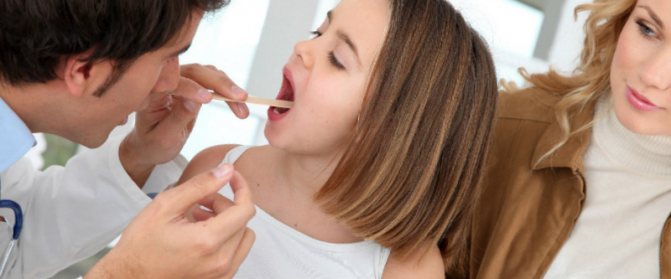
Kids cannot explain that they feel bad. If the baby begins to eat poorly, is capricious, or the temperature has risen, then check the throat. This is difficult to do in low light conditions. And trying to turn the baby towards the light is also difficult. To make the task easier, just have a small flashlight ready.
How to determine a sore throat in a child:
- Loss of appetite;
- heat;
- difficulty swallowing food or saliva;
- feeling of dryness and tickling;
- redness in the visible part of the oropharynx, on the soft palate, palatine arches;
- cough;
- light spots, plaques;
- enlarged tonsils, possible pus, plaque;
- white cheesy coating.
When is it necessary to call an ambulance or a doctor at home?
People urgently seek help from specialists for sore throats in children accompanied by:
- headache and sudden increase in temperature - 38-40°C;
- difficulty breathing and swallowing food or liquids, including saliva;
- wheezing when inhaling and exhaling;
- pain syndromes in the ears (ear);
- nausea and vomiting;
- sudden swelling of the tonsils of the palate and the appearance of a whitish and purulent coating on them;
- pain and swelling of the joints;
- skin rashes;
- pain in the lymph nodes when they suddenly enlarge.
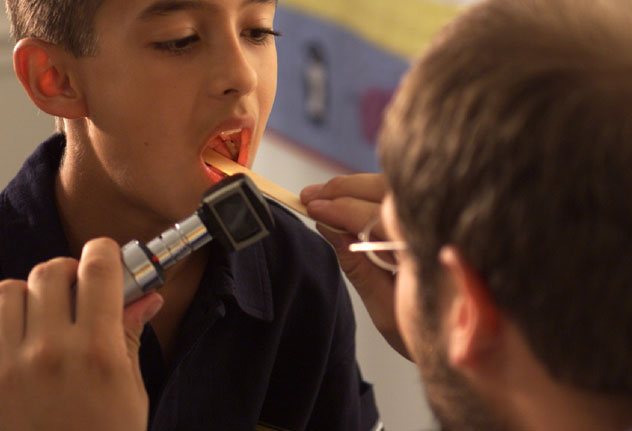
Why does a child have a red throat?
Every parent worries why a child may have a red throat. Common reasons are described below:
- Acute tonsillitis (angina). It comes in different forms. In children, the course is very difficult; without timely treatment, complications are possible.
- Pharyngitis, which can occur independently or occur against the background of other diseases. For example, ARVI, bronchitis, rhinitis. Therefore, local treatment of the throat alone cannot be done here.
- Allergy.
- Gastrointestinal diseases.
- After hypothermia: a long walk in the cold, clothes that are out of season, a poorly tied scarf.
- Weakening of the immune system. Infections enter the body through the nose and throat. If the beneficial bacteria in the larynx are weakened, they cannot fight back. This also happens with the lymphatic system, which guards health.
- External irritants: too hot drink or food. Cold drinks. Very spicy, salty dishes.
Why a child has a red throat is difficult to determine without proper knowledge. So don't put off visiting your doctor. The specialist will be able to select an effective treatment regimen.
A child often has a sore throat: methods of treatment
Pain when swallowing often accompanies viral and colds.
On the surface of the mucous membrane in the oral cavity, pathogenic bacteria (staphylococci and streptococci) multiply.
A factor facilitating the penetration of harmful microorganisms is reduced immunity.
The inflammatory process is mainly localized in areas of the tonsils.
What to do if your child often has a sore throat? What treatment procedures should be performed?
Why does the child get sick? Having determined the cause of the disease, you can choose the right treatment method.
The most common discomfort when swallowing occurs as a result of:
- Viral infections;
- Fungal diseases;
- Bacterial infection;
- Dysbacteriosis of the oral cavity and tonsils. It may result from the use of antibiotics;
- Allergies;
- Chemical and mechanical damage to the surface of the oral mucosa;
- Presence of chronic foci of infection in the oral cavity.
In the presence of the above factors, the child’s larynx may become inflamed and red. If immune defense is reduced, the infection quickly enters the body.
The cause of unpleasant sensations in the throat can also be poor ecology and the presence of dry air in the room.
Red throat in a child: how to treat it
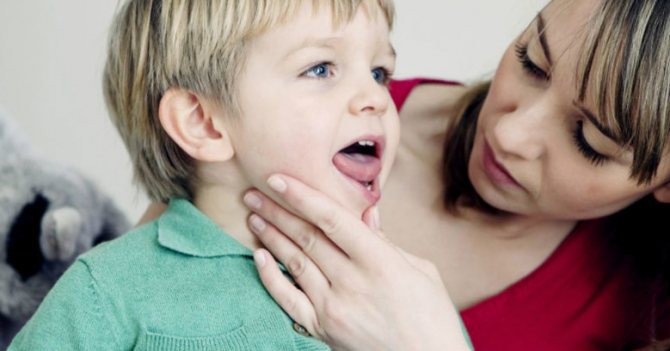
A sore throat in a child must be treated immediately; it will not go away on its own. To complicate the situation, a number of drugs are not suitable for young children. Little ones should not take lozenges because they may choke. Here are some remedies that may help. Please read the contraindications and side effects carefully.
A table from a pharmacist by age on how to treat a red throat in a child.
